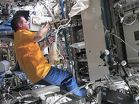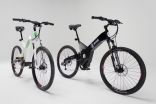HUNTSVILLE, AL, March 06, 2013 (Press-News.org) Have you ever wondered how we develop new materials or find out what properties we can change in existing materials to improve them? Scientists and researchers at NASA are doing just that through materials science research using the Materials Science Research Rack (MSRR) aboard the International Space Station.
Materials science research is the applied study of the properties of matter and substances. This type of research in space benefits from the microgravity environment, and it allows researchers to isolate chemical and thermal properties of materials from the effects of gravity.
The MSRR is about the size of a large refrigerator and contains two furnace inserts that can heat materials to temperatures of 2,500 degrees Fahrenheit. Cartridges are placed inside the furnace insert one at a time for processing. Once a cartridge is in place, the experiment can be run from the ground. Processed samples are returned to Earth as soon as possible for evaluation and comparison of their properties to samples from similarly processed cartridges on the ground. Researchers have used the rack to process 16 samples of different materials since the facility launched to the space station in 2009.
In late 2011, there was a loss of communications between the MSRR and the computer that controls it. The automatic safety procedures on the rack caused it to shut down as designed; but, in doing so, it also caused the temperatures inside the furnace to exceed their normal limits. These higher temperatures caused some of the material inside the furnace to become bonded to the furnace itself. This required the station crew to clean the furnace and remove the materials.
To prevent such an event from happening again, Shawn Reagan, manager of the MSRR project at NASA's Marshall Space Flight Center in Huntsville, Ala., and his team worked with Marshall engineers to design a software upgrade for the MSRR. This update will prevent this scenario from occurring in the future, allowing the facility to begin processing samples again.
"The MSRR has been a great tool in understanding how different materials like ceramics or metals react when heat is applied to them in space," said Reagan. "The original design of the software that controls the MSRR called for it to shut down within 30 seconds of losing communications from the main computer that controls it. Through our experience over the last several years on how the MSRR operates, we were able to design a much more efficient software program that will allow the furnace to stay operating for up to three hours after losing communications. This will give researchers enough time to troubleshoot any problems and prevent any contamination of the furnace due to overheating of materials."
Getting the MSRR back online is important because applied materials science is essential for the development of new, safer, stronger and more durable materials for use throughout everyday life. One of the goals of performing research in space is to gain a better understanding of the role of gravity in the microstructural development during solidification.
One of the first experiments performed on the MSRR melted and solidified an aluminum and silicon alloy. This type of processing typically is used for producing commercially important products such as high temperature turbine blades.
The MSRR was fired up on Jan. 23 and began its work processing the first of 11 new samples that will be tested over the next several months.
"Everything looks great and the first sample was processed successfully," said Reagan. "We are really proud of our team for working through these issues with the MSRR and designing this software to make it work even better. This is what science is all about -- working through challenges and coming out of those with an even better product."
For more information on past, ongoing, and future ISS research activities, including research results and publications, please visit:
http://www.nasa.gov/mission_pages/station/research/index.html
If you are interested in subscribing to updates from the ISS Program Science Office, please visit:
https://lists.nasa.gov/mailman/listinfo/iss-program-science-group
For more information about the International Space Station, visit:
http://www.nasa.gov/station
For information about NASA and agency programs, visit:
http://www.nasa.gov
Materials Science Research Rack Heats Up For Valuable Space Station Science
RELEASE: JR13-015
2013-03-06
ELSE PRESS RELEASES FROM THIS DATE:
Bioplanet Reinvented the Bicycle with the Bike
2013-03-06
Bioplanet today introduced Bike, combining several products into one - a uniquely designed bicycle, an e-bike with a bottom bracket integrated electric motor and pedelec as electric bicycle with power assistance - into one lightweight and distinct electric bicycle. The Bioplanet Bike introduces a new bicycle frame design with integrated electric components which completely redefines what riders can do with their bikes.
Bioplanet Bike is a revolutionary product that sets a new era and trends in bicycle and light electric powered vehicles design. "Our Bike is the ...
Neighborhood poverty and health insurance figure in late-stage diagnosis of breast cancer
2013-03-05
Springfield, Ill., February 7, 2013 – Home may be where the heart is, but where you live could affect your health.
"Regardless of geographic location, women who live in high poverty areas or are uninsured are at greatest risk of being diagnosed with breast cancer at a later stage," said lead author Kevin Henry, Department of Geography, University of Utah.
A team of scientists was assembled by the North American Association of Central Cancer Registries (NAACCR) to examine breast cancer stage at diagnosis among 161,619 women aged 40 years and older diagnosed in ten participating ...
Pregnant mothers with strong family support less likely to have postpartum depression, study finds
2013-03-05
Women who receive strong social support from their families during pregnancy appear to be protected from sharp increases in a particular stress hormone, making them less likely to experience depression after giving birth, a new study by UCLA life scientists indicates.
"Now we have some clue as to how support might 'get under the skin' in pregnancy, dampening down a mother's stress hormone and thereby helping to reduce her risk for postpartum depression," said Jennifer Hahn-Holbrook, a UCLA National Institute of Mental Health postdoctoral scholar in psychology, a fellow ...
For birds, red means 'go'
2013-03-05
New research has shown that certain Australian native flowers have shifted away from using insects as pollinators and evolved their flower colour to the red hues favoured by birds.
In a study published in New Phytologist, biologists from Monash University and RMIT University have shown for the first time that Australian native flowers exclusively pollinated by birds have evolved colour spectral signatures that are best discriminated by those birds.
Dr Adrian Dyer of Monash and RMIT said previous studies had shown that flower colour evolved to attract bees as pollinators.
"We ...
Genetics Society of America's Genetics journal highlights for March 2013
2013-03-05
Bethesda, MD—March 5, 2013 – Listed below are the selected highlights for the March 2013 issue of the Genetics Society of America's journal, Genetics. The March issue is available online at www.genetics.org/content/current. Please credit Genetics, Vol. 193, MARCH 2013, Copyright © 2013.
Please feel free to forward to colleagues who may be interested in these articles on cellular genetics; population and evolutionary genetics; genome integrity and transmission; and genome and systems biology.
ISSUE HIGHLIGHTS
Cellular Genetics:
Systems genetics implicates cytoskeletal ...
New gene variant may explain psychotic features in bipolar disorder
2013-03-05
Researchers at Karolinska Institutet in Sweden have found an explanation for why the level of kynurenic acid (KYNA) is higher in the brains of people with schizophrenia or bipolar disease with psychosis. The study, which is published in the scientific periodical Molecular Psychiatry, identifies a gene variant associated with an increased production of KYNA. The discovery contributes to the further understanding of the link between inflammation and psychosis – and might pave the way for improved therapies.
Kynurenic acid (KYNA) is a substance that affects several signalling ...
Discovery of human genetic mutation could lead to new treatments for type 1 diabetes
2013-03-05
In type 1 diabetes, the immune system destroys insulin-producing cells in the pancreas, but the precise cause has not been clear. A study published by Cell Press on March 5th in Cell Metabolism reveals that a single mutation in the "longevity gene" SIRT1 can cause type 1 diabetes in humans. The findings unearth the role this gene plays in human autoimmunity and disease and also offer new avenues for treating a range of autoimmune disorders.
"We describe one of the first single gene defects leading to type 1 diabetes, as well as the first human mutation in the SIRT1 gene," ...
Molecular coordination in evolution: A review in 'Nature Reviews Genetics'
2013-03-05
Spanish National Cancer Research Centre (CNIO) researchers Alfonso Valencia, Director of the Structural Biology and Biocomputing Programme and David de Juan, jointly with Florencio Pazos, from the Spanish National Centre for Biotechnology (CNB-CSIC), publish a review on the latest computational methods that, based on evolutionary principles, are revolutionising the field of analysis and prediction of protein structure, function and protein-protein interactions, as well as the short- and long-term expectations for the field.
"The computational and mathematical analysis ...
How cells optimize the functioning of their power plants
2013-03-05
Mitochondria, which are probably derived from distant bacterial ancestors incorporated into our cells, have their own DNA. However, we know little about how these organelles, which convert oxygen and consumed nutrients into energy, regulate the expression of their own genes. Jean-Claude Martinou, professor at the University of Geneva (UNIGE), Switzerland, and his team, have discovered the existence of compartments at the heart of mitochondria, consisting of hundreds of different proteins. It is here that RNA molecules (the many copies made from DNA) come together to be ...
Single gene might explain dramatic differences among people with schizophrenia
2013-03-05
March 5, 2013 (Toronto) – Some of the dramatic differences seen among patients with schizophrenia may be explained by a single gene that regulates a group of other schizophrenia risk genes. These findings appear in a new imaging-genetics study from the Centre for Addiction and Mental Health (CAMH).
The study revealed that people with schizophrenia who had a particular version of the microRNA-137 gene (or MIR137), tended to develop the illness at a younger age and had distinct brain features – both associated with poorer outcomes – compared to patients who did not have ...
LAST 30 PRESS RELEASES:
Deep ocean earthquakes drive Southern Ocean’s massive phytoplankton blooms, study finds
Without campus leftovers to pick through, the beaks of this bird changed shape during the pandemic
High-dose antibiotic does not reduce mortality in tuberculous meningitis
How many insects fly in the sky above the USA?
Could cheese protect your brain health?
Who faces more difficulty recovering from stroke?
Colliding galaxies create the brightest, fastest growing black holes at their center
New BrainHealth research reveals tradeoffs on sleep with cannabis use for chronic pain
Aging-US now on ResearchGate, enhancing visibility for authors and readers
'Molecular glue' stabilizes protein that inhibits development of non-small cell lung cancer
Mount Sinai Health System is recognized in 2025 Chime Digital Health Most Wired survey
From prey to predator: How carnivores spread beneficial fungi
Menopause symptoms may be frequent and have negative effects, according to female endurance athletes
US Congressmembers’ responses on X to mass shooting events differ along party lines
KAIST-UEL team develops “origami” airless wheel to explore lunar caves
Individual genetic differences render some therapies ineffective
Engineering dendritic cells boosts cancer immunotherapy
Sophisticated neuroimaging reveals PTSD in WTC responders is linked to measurable physical changes in brain structure
Health policy experts identify promising strategies for providing health care to homeless people
Study explores role of neutrophils in canine atopic dermatitis
Mayo Clinic researchers develop AI-ECG model to diagnose liver disease earlier
Heavy menstruation common among teenage girls – questionnaire reveals risk of iron deficiency
New study explores why open water swimming feels so powerful for midlife women
In echo of Jurassic Park, mosquitoes capture entire ecosystems in their blood meals
Marty Cooper, Illinois Tech Alumnus and ‘Father of the Cell Phone,’ Receives 2025 Marconi Society Lifetime Achievement Award
How to reduce the risk of lymphedema
NEJM Evidence and CIDRAP announce Public Health Alerts
New fossil study illuminates on the evolutionary success of frogs
Patient-specific human liver model to understand disease mechanisms
Confused by the doctor's questionnaire? U of A study suggests it's common
[Press-News.org] Materials Science Research Rack Heats Up For Valuable Space Station ScienceRELEASE: JR13-015



